
How special is this film to me? Let me quote from my own amazing origin story. The hero, a high school-aged Ken Begg:
“I can remember the exact moment watching Bad Movies became a part of my life… The kindling was provided by [the book The 50 Worst Films of All Time]. The spark soon appeared. Late one Saturday night, my mother called up the stairs to where I was ensconced in my room. She bade me downstairs, saying that if I was looking for bad movies, she had a doozy.
There, on her 19 inch bedroom TV screen, ran a movie that I immediately recognized as “The One”. It was a simply awful flick about some high school kids and their adventure with Bigfoot. As the remaining half hour ran, I sat mesmerized. The next day, I looked in the TV Guide and learned that the title of the movie was Curse of Bigfoot. I never looked back.
The fire was kept alive in part due to a comrade-in-arms to share this odd hobby with. I had met Andrew Muchoney in high school as part of a group of people who hung out together. Among his various occupations, Andrew had a background similar to mine in terms of monster movies and sarcasm. I excitedly described Curse of Bigfoot to him. Luckily, by keeping an eye on the TV listings, I was able to find a repeat showing, and garnered an early video recording.
Andrew’s viewing of my copy resulted in a similar enthusiasm. Shortly after, we hooked another classic, Larry Buchanan’s It’s Alive (not to be confused with Larry Cohen’s “mutant baby” flick). We were teenagers, and so brought a certain passion to our new hobby. We would watch Curse of Bigfoot (and later It’s Alive) over and over and over again. Amazed at how slow segments of either film were, we would time sequences by watching them again. Then forgetting how long exactly the scenes were, we would conduct the experiment again.
Sometimes, operating under a “Chicken” principal to see who would surrender to common sense first (the loser), we would watch the films repeatedly over the course of an evening. We’ve between us seen hundreds, perhaps thousands, of Bad Movies in the decade and a half since.* None, though, were studied with the fervor and detailed preoccupation with which we gawked at those two. They were, in terms of the hobby, our first loves.”
[*Now rather longer than that.]As such things work, my first was not as mature, as subtle, as sophisticated as the loves of later years. Curse of Bigfoot wears its manifest badness on its sleeve, offering everything with casual abandon, withholding nothing. It is cheaply budgeted, woodenly acted, inanely scripted, poorly shot, ineptly edited and cynically composed. You needn’t work for its charms, they are freely given.
I adore it still.
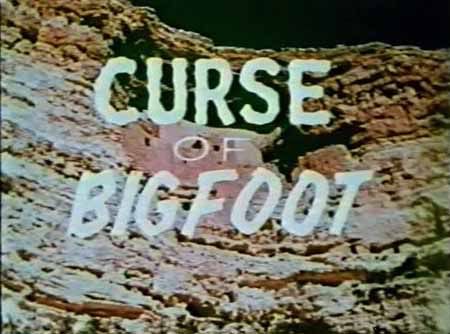
We open with generic, slightly fuzzy swamp footage. The quality and particularly the muted color palette of these shots will strike a familiar cord to anyone who was a public school student from the 1950s through the ‘70s. The accompanying music is equally generic, as are the echo-y monkey chatters used to suggest Primal Nature As Yet Unbesmirched by Man. Actually, it reminds me a great deal of Journey to the Beginning of Time, a dubbed Czechoslovakian dinosaur movie that ran in serial form here in Chicago on the Garfield Goose show back in my youth.
The music itself is clearly meant to inject a note of somewhat ponderous menace to the proceedings. Adding to this is the Narrator, who tells us of Ye Ancient Times, blathering over a tracking shot of black footsteps in the sand, and then a tracking shot of white footsteps (apparently highlighted with a thick coat of Elmer’s Glue) in the sand. These increasingly human-like imprints purportedly mark the evolution of Man.
“It happened! two million years ago. In steaming swamps and prehistoric jungles, the earliest man-like creature walked the Earth. Not human; more beast than man.* A monster of evolution. It walked across the eons of time, slowly changing, becoming more and more human, more and more advanced.”
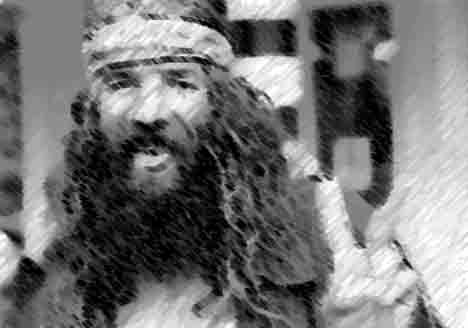
“Until, in the Pleistocene, just thousands of years ago, Man himself emerged. But the change from beast into Man was not a steady one. Sometimes, primitive Man would find his life threatened, terrified, by the appearance of a monster from the past*!”
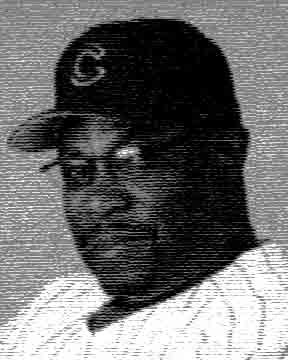
With this introduction, we now suddenly espy a fellow in what yet remains the mangiest, most moth-eaten quasi-apeman suit I’ve ever seen. In a shot that instantly procured the film a place in my stony heart, a close-up of the truly laughable mask reveals that the creature’s ‘eyes’ were solid ovals of black plastic. They thus of necessity had to hack a single, yet entirely evident, hole out of one of them, in order that the poor sap in the suit could see anything at all.
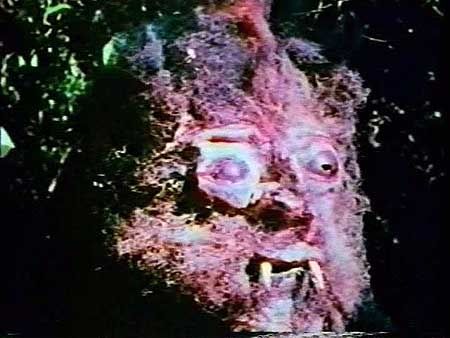
“Rah, I am a monsta.”
To the accompaniment of shrill cords, this primordial terror charges drunkenly towards the camera, presumably hoping not to trip for the eleventh time as the poor sap stuck in the suit desperately peers through that teeny little hole in his mask. In any case the creature’s luck holds, and his prey, a primitive forebear of ours, dies writhing on a rock. So gruesome is this attack that the victim unleashes an entire bottle of barbecue sauce to mark his demise.
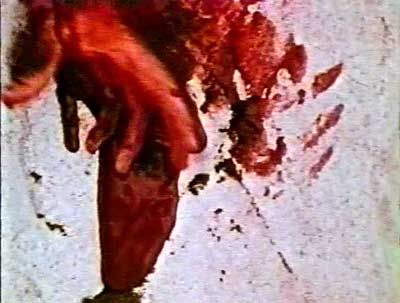
Cue the opening credits, as we see stock footage of Hopi pueblos and other such non sequiturs. Then we see a sight that will become all too familiar over my long decades as a bad movieologist: The bright sun peering through the branches of a tree, counterintiutively belayed by a bluish tint and loudly dubbed-in cricket sounds, both universal shorthand for ‘day for night’ shots. Even so, it takes a special kind of genius to introduce said footage with, again, a tinted shot of what is either the blazing sun, or the Moon gone supernova.
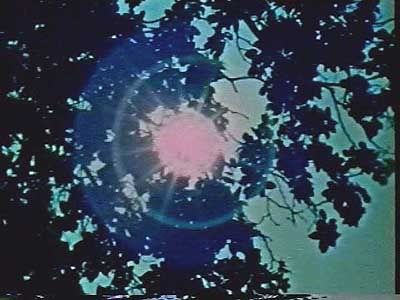
Anyway, having established that is it ‘night,’ we move on several shots of an isolated (but clearly suburban-looking) house. Then we get another shot of the sun, just to screw with us, I guess. Then it’s on to the ‘woods,’ where something is moving through the foliage. This proves to be a person in a Nehru jacket, a Beatles haircut and a face which appears to have been grievously disfigured by an exploding taffy apple. This is, as you’d guess, a Monster.
The Monster moves rather torpidly through the trees, almost as if he were trying to eat up as much (ironically named) running time as possible. Meanwhile, the director gets fancy, shooting up from the ground so that we get a truly sinister vantage of the underside of the Monster’s chin.
There follow more shots of the house, or, to be technically accurate, a repeat of shots already seen. Here we meet our next character in our Tableau of Destiny, a large black hound sitting in the yard of said house, his ginormous tongue hanging down like a pink, moist Tapestry of Fate. Then trees. Monster. House. The Dog begins barking. Monster. House. Dog barking. Trees. Repeat of Bottom of the Monster’s Chin shot. Dog barking….
Are you starting to see a pattern here?
Eventually, thanks to a pointless yet exceedingly slow and protracted zoom shot—the film was apparently shot in Molass-O-Vision™—we see the interior lights of the house snap on. And so enters our Final Player. This is The Lady, who emerges upon the porch in a voluminous, not to mention hideously ugly, housecoat. To emphasize her irate nature, she pauses to lodge her hands against her hips. “Scotty!” she cries, referring, presumably, to the Dog and not the Monster.
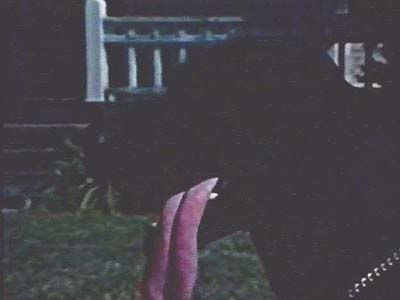
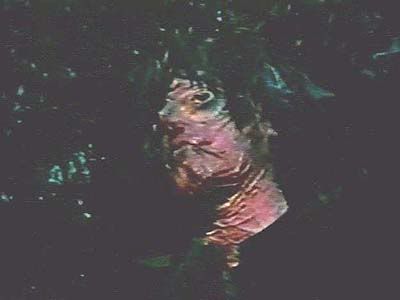
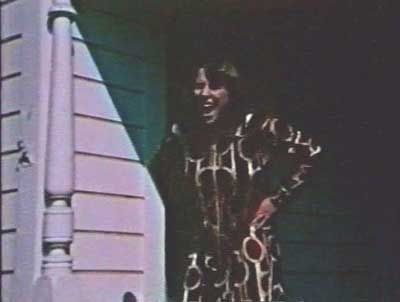
The Lady approaches Scotty so as to continue to remonstrate with him. Amazingly, despite the fact that we clearly saw both her empty hands when she made Angry Arm Triangles on the porch just a few seconds ago, she now enters shot with Scotty bearing a large pitcher of milk. Apparently this is just kept out in the yard and she grabbed it on the way over.
“You’re making enough noise to wake up the dead,” she observes, a statement perhaps provided with ironical intent on the filmmaker’s part. However, since we have no idea if the Monster is undead or not, this is conjecture at best. In any case, she pours Scotty a large bowl of Yard Milk, and to our delight we get to watch Scotty lap up the entire contents of this, more or less in real time.
During this fascinating display, sure to elicit rapt captivation from members of the National Dairy Council, The Lady proceeds to pet Scotty as the Monster continues to shuffle his way towards the scene’s dénouement. Eventually…and I do mean eventually…we cut to a static shot of The Lady in the foreground, who now mimes petting a clearly no longer present Scotty while we in the audience, godlike, observe the exceedingly measured approach of her rather lackadaisical doom.
Only after the Monster reaches her, following roughly half an hour of Ominous Creeping, does Scotty the dog make a halfhearted attempt to bark out a warning. One can only posit that Scotty was in fact an evil Machiavelli of Mutts, who cannily barked earlier solely to lure his poor, trusting mistress to disaster, and then sat sleekly silent as Horrible Death stole leisurely towards her. Presumably this final spasm of barking represented Scotty’s malign, canine gloating. How he must have sneered with doggy derision when The Lady affectionately, if woodenly, queried, “Must you bark at every jackrabbit?”*
[*Despite the brevity of her performance, the woman playing The Lady displays that mystifying complete inability to deliver a sentence in a manner which suggests she has ever actually spoken aloud in real life, or heard anyone else do so. Her stuttering read of “Scotty, if you’re good for the rest of the night, and don’t awaken, anyone else, I’ll promise to take you hunting with me tomorrow,” must be heard to be disbelieved.]So, let’s take a quiz. Consider the events as I’ve described them. Basically: Monster in woods, dog barks, lady emerges from house, Monster steals upon lady and smites her. So how long do you think such a scene would take to unfold?
Answer: Six minutes.
What’s that, you say? You’re unimpressed? Six minutes doesn’t sound like that much? Let’s experiment further. Turn to the nearest analog clock or wristwatch. Stare at it, without deviation, for six straight minutes. Admittedly, that’s not a perfect analogy, since the clock will provide much more entertainment, what with that second hand whipping around at a dizzying, NASCAR-like pace. Still, it will give you a faint notion of what I’m talking about here.
In any case, just before the actual kacking, we cut to a darkened room and a close-up of an old-style movie projector. In a twist clearly designed to completely BLOW YOUR MIND, it turns out the above described, er, action (?) was actually a film being watched by a class of about a dozen high school students.
Their instructor is one Mr. Whitmore, one of those unctuous prats whose helmet of hair (albeit with one scalp-revealing divot on the side) and smarmily theatrical, self-satisfied manner pronounce his belief that he’s one of those ‘hip’ teachers who can not only teach but ‘relate’ and ‘rap’ with the kids. Lucas Tanner and Room 222 had a lot to answer for. I will say, however, that his drab, inexpensive-looking sports jacket and tie look about right.
Of course, what do you expect from a guy who’s teaching a barely-attended high school class on monsters? No, really. He has old woodcut posters of ancient monsters (the Kraken, etc.) up on display and proceeds to lecture his charges on various cryptozoological subjects. First, though, he bloviates pompously on the ‘film’ they just watched.
“Here,” he opines, “you have the classic example [!] of the Hollywood monster. The movie studios turned out films like these by the hundreds back in the ‘50s and early ‘60s. [Well, sorta….] *chuckles* Werewolves. Vampires. Monsters created by atomic radiation. Creatures from outer space. They all did their part to paralyze the kids at the Saturday matinee…and [arching brow] to give the girls an excuse to move as close as possible to the boy at the drive-in?”
This last is delivered with a slight leer that makes his winking pervertedness easily the scariest thing in the movie. As the students grimace uncomfortably in response, one gets the impression that it’s only previous stern lectures from the principle that keep him from continuing on in the vein: “Then, the smell of her hair. My god, the smell! Then the grappling, the loud, fevered explosions of hot humid breath, the delicious, agonizing fumbling at the buttons…” And then the classmates have another tale to tell during lunch period of the cops escorting Mr. Whitmore out of the room.
Having seemingly mastered himself this time, however, Whitmore moves on. He begins to talk of more modern horror movies. “All of you have seen recent films about the devil and demon possession. Even the film about the great white shark was a monster story of sorts, a modern day sea monster…” Apparently Whitmore is under the misapprehension that actually saying film titles violates some sort of copyright stricture. Meanwhile, the camera cuts to show his students taking in these ramblings with hilarious raptness.
Finally, noting, “Man has always had his monsters,” Whitmore moves on to the woodcut posters mounted on his chalkboard. Apparently smooth transitions aren’t one of his strengths. He continues to treat the subject with complete seriousness, however. “Very real, and sometimes, most unexplainable,” he mumbles, referring to the posters of cartoonish beasties. I’m not even sure what that means. In what contexts are monsters sometimes explainable and other times not? I’m not sure I’m following this.
Whitmore notes that today they’re concluding their “study of the supernatural, the powers and beings outside the reality of nature. So I’ve invited a guest speaker.” This, as we’ll see, proves to be a guy who had a run-in with Bigfoot. So I guess Bigfoot is “supernatural” and “outside the reality of nature.” Just as we’ve always thought of him. Say what you will about Whitmore pedagogical technique, but the man really knows his subject material.
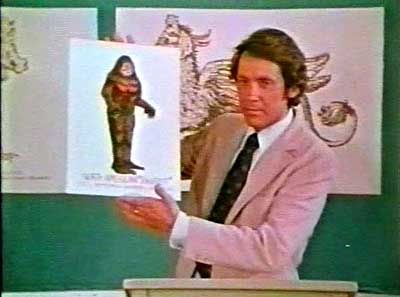
Sadly, this guest has not arrived as of yet, so Whitmore preps the class on the fellow’s qualifications. “This man is a science teacher,” Whitmore declares from his podium, “as well as a widely-read author and a recognized authority on the phenomenon known as the Abominable Snowman, or, as this creature is known in North America, Bigfoot.” Uhm, well, sorta, I guess. Still, a guy who’s both “widely-read” and a “recognized authority”? Can’t argue with those credentials!
And…go to the stock footage, accompanied by library music apparently composed by someone who watched a lot of Johnny Quest episodes. The images include shots of mountains, possibly in the Himalayas. My favorite, however, is this one stretch were we are shown a series of radar arrays. This are accompanied by the line “…the search for these giant, man-like creatures…,” which forces one to ponder exactly how big these Yetis are if they are monitored via radar. ‘Giant’ creatures, indeed!
Said search, we are told, “started with the discovery of mysterious, huge footprints, which obviously were not made by any known form of human life.” And so off to the Himalayas, as we see footage of people looking over a map, a plane in flight, more mountains, the plane again, etc. Whitmore continues to provide (apparently outrightly fictional) details of folks like “mountaineer Eric Stapleton” discovering Yeti tracks.
Like his forthcoming guest, Stapleton was someone to reckoned with. He “was a professional photographer, as well as an educated scientific investigator and mountaineer.” Not to mention a college star-level fullback, recognized gourmet chef and acknowledged expert on the influences of the zodiacal signs on tidal patterns. He also was a highly qualified expert cobbler, a universally respected master of the Wushu martial arts, and wrote a popular Soduku column for a major publication.
Indeed, Stapleton’s photographs of “giant footprints” were, we’re told, published in papers around the world. “For the first time,” Whitmore explains, “the public began to know of the existence of a giant, man-like monster, which actually exists in the Himalayas. A monster known as Yeti, or, Bigfoot.” Uhm, well, sorta, I guess.
“Within two years, the reports of giant footprints within the wilderness areas of the world, spread from the Himalayas, into North America itself. [Well, that proves it.] In May of 1956, a man by the name of James Hunt, not only discovered footprints along the muddy banks of the Fraser River near Alberta, but Hunt actually sighted the Bigfoot monster, running into the woods. Unfortunately, he had no camera with him. And many people here in America said he was crazy, that the footprints were fake!” [Please, that’s what they said about those crop circles that were clearly left by UFOs, right? Cover-up!]
Still, naysayers aside, you can’t argue with the mounting, irrefutable evidence Whitmore provides. “But…over the next few years, reports continued throughout Canada, Washington State, Oregon, even into California. [And we know how level-headed they are in California!] It soon became apparent that Bigfoot was not just a hoax. Something was there, leaving giant footprints deep in the wilderness. Bigfoot was real.” Well, obviously.
Cut to a long stretch of logging processing footage clearly taken directly from an industrial short, complete with driving music. As such, it’s probably the most competently executed sequence we’ll be seeing here. This goes on for several minutes, accompanied only by Whitmore’s voiceovers. Such a thing would surely have impressed even Roger Corman for its thriftiness and spit-in-the-audience’s-eye audacity. (Even though there was a whole cottage industry of films just like this in the ‘70s. More on that later.)
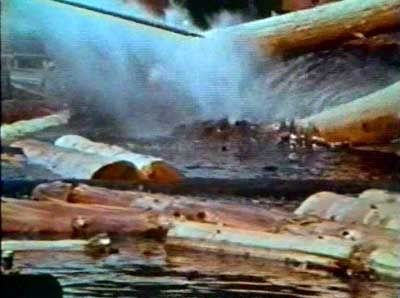
And so we watch several straight minutes of logs rolling into a river (lots and lots of logs) and loggers cutting trees, and bulldozers moving through the woods, and, occasionally, a brief glimpse of a bedroom slipper modified to look like a Bigfoot foot. We also start getting purported Bigfoot POV shots, and given his breathing, the creature was either asthmatic or moonlighted as Darth Vader. In any case, watch for the one, joyous moment where the ‘Bigfoot’ shadow hits a tree and we can clearly see the outline of the camera on the cameraman’s shoulder.
Meanwhile, Whitmore continues building his case, with phrases like “proved beyond a doubt” and assertions such as “It was obvious they were becoming as curious about us as we were about them,” and “Very few educated observers would still deny that something was really out there, there was an incredible man-like monster actually living in the North American woods” and references to “strands of long, black hair tangled in tree branches. Hair which, when examined by scientists, proved to have come from some mysterious creature previously unknown to man.” It’s true, you can see these hair samples in the Smithsonian’s ‘Bigfoot is Real’ wing.
By the way, if I had a dollar for each time Whitmore refers to the creatures as “huge” or “giant” or such, I’d have had enough to fund this movie, and probably a sequel. Keep this in mind for later.
As if this wasn’t all the evidence one could possibly need, we now get more, in form of an anecdote (and ‘original’ footage, to boot!). “These two men were destined to become the first unfortunate persons to encounter Bigfoot, face to face.*” So saying, for a good long while we watch a small truck drive through the forest at a clip of, literally, about five miles an hour. The trucks that transported the nitro in Wages of Fear drove faster than this.
[*Actually, this isn’t even true. As we’ll see, only one of them ‘encounters’ Bigfoot.]Just when our nerves can take no more hot driving action, we finally see something else: A hairy dude, or something in a fur, or maybe even a Bigfoot, runs across the road way in front of the truck. The guys get out of the truck, and prove to be the ourdoorsy Sean Connery in a Stocking Cap and Flannel Shirt Doug Henning.
Connery goes into the trees to look for whatever it was, and looks, and looks, and looks. Occasionally we get a Bigfoot POV shot, or see the slipper-foot, or cut back to Henning. Mostly we get boredom, accompanied by the same irritating piece of music played over and over again. Eventually Connery picks up a stick, just in case, I guess. He then has it in some shots and not in others as he continues to stroll around. Presumably it was kept in the same place as Scotty’s milk jug.
This goes on a while…a long while. Eventually Henning, presumably fearing his friend has starved to death and is currently just a skeleton, goes off to look for him. The most exciting moment of the entire segment is when Henning nearly slips running down a hill.
After more such shenanigans Henning hears a not-entirely believable scream. He rushes forward and finds Connery sort of rolling on the ground with his hands over his face, but seemingly unhurt. Henning looks briefly confused—he’s not the only one—and End Scene.

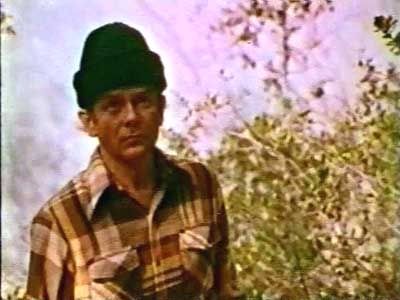

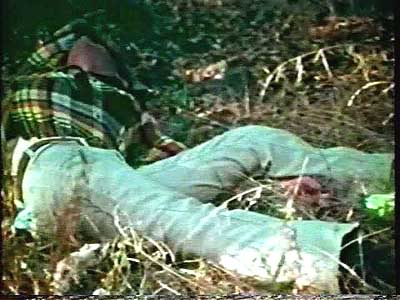
The above three paragraphs accounts for fully seven straight minutes of running time.
Astoundingly, at least one of Whitmore’s students is still awake. Apparently he’s the audience identification character (except for the ‘being awake’ part), since he responds by asking “You except us to believe all this?” Confused by this display of common sense skepticism, as public school teachers often are, Whitmore replies by quoting Shakespeare (!!), the whole “there are more things in heaven and earth”, etc. [Well, that proves it.] I think the Bard would have been less embarrassed by this line’s appearance to open King Kong vs. Godzilla than its use here.
The best part is that Whitmore really seems somewhat offended by this, as he is apparently a true believer. (I’m assuming today he’s teaching, in much the same fashion, Anthropomorphic Global Warming.) “The greatest mistake a man can make is to disbelieve what he hasn’t seen,” he responds. Well, that proves it. He then rambles on about “evil powers” and “fantastic creatures,” and warns the youngsters that such disbelief could “sometimes result in a dreadful consequence.” Such as, I assume, sitting in this guy’s class all year. Again, though, most of the students listening to this appear to be drinking in this bilge with the utmost seriousness.
With his promised guest even yet absent, Whitmore decides to waste more time with an impromptu spot quiz. This allows a little camera time for some of the assembled students. To the good, these are pretty evidentially real, actual high school kids, and to the bad (by which I mean their ‘acting’), these are real, actual high school kids. Kids today, who have grown up in a world in which they are themselves constantly recorded, would no doubt find the student’s on-camera awkwardness alien and bewildering.
The first student, Anne, browscrunchingly identifies one of the posters of “ancient sea monsters” (as Whitmore labels them) as “one of the dragons from the 16th century, I think.” Whitmore approves of this answer, and moves on to a poster of what is supposedly a Griffin.
Sadly, this allows for the appearance of the Odious Comic Relief, in the form of a particularly baleful example of the ‘class clown.’ He recites the “bird monster’s” (I thought Whitmore said these were “ancient sea monsters”?) characteristics, which he gleans not from memory from just from staring at the poster in front of him.
However, he then inspires paroxysms of gibbering laughter from his classmates (clearly dubbed in) when he finishes by noting, “It eat everything, except your shoes. When the Griffin got you, all they’d ever find, was your shoes!” The raucous convulsions of mirth this assertion inspires mark the film’s single most outlandish incident.
Whitmore lets the class have its head for the moment. However, he then masterfully reasserts his place as Alpha Male by catching the Class Clown off guard with the following question, delivered, I swear, with a piercing glare. “What I want you to tell us, is when the legendary Griffin got its start?” Class Clown, put in his place, gloweringly ceases his class-disturbing observational humor.
His point made, Whitmore instead calls upon apparent surfer-dude Andy, whose flowing blonde Leif Garret hair presumably made him quite popular with his female peers. Andy is given one pivotal line, and he makes sure to emphasize the key word as instructed: “The Griffin was invented in the fourteen-hundreds by the Germans.”
Why such an awkwardly-phrased statement, and why the emphasis on that particular verb? All is revealed when the recently arrived guest speaker, one Roger Mason, erupts in response. “Really? I wonder,” he growls in his gravelly voice, surging towards Andy and shaking his notebook in the hapless student’s face. “I wonder, young man, if the ancient Griffin was really… invented, as you say… by some, demented madman?!” Happily, some wise soul downloaded this entire scene to YouTube, so you can watch it in all its glory. I mean, the guy really sells that last line and makes it a thing of beauty.
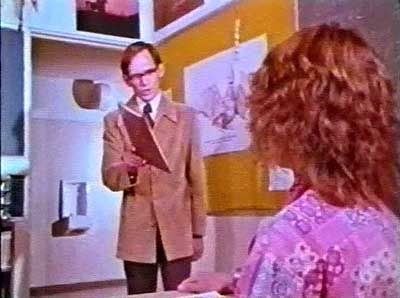
The room falls silent for a moment, as you’d expect, before Whitmore jumps in with a British-like intent to paper over the entire incident. “Roger!” he says, and drags the guy to the front of the class before any actual assault is committed. Even so, you can see why he believes this is the calm, Spock-like logician whose presentation will convince the kids of the reality of Bigfoot, and, apparently, Griffins.
Adding to this is Roger’s own fatalistic admission that “I wonder, if I should have come.” Whitmore has no such doubts though—I mean, even if Roger had killed Andy, he’d still have upwards of a dozen students left—and drags Roger behind the podium. Then, apparently still hoping to put the Recent Unpleasantness behind them, Whitmore again sings Roger’s praises. “I want to introduce you to a man who has spent much of his life assaulting strangers who express doubts as to the existence of mythological creatures as a teacher, and as a patently undermedicated lunatic highly respected scholar.”
Aside from noting that Roger has written several books on Bigfoot, he also again sells the notion that Roger has had a personal “experience…incredible experience…with the giant man-beast of America.” No, not Rosie O’Donnell. And note again the statement that Bigfoot is a ‘giant.’
Roger girds himself to speak, and let’s just say that in the years since his Bigfoot encounter (as we’ll soon see), he has picked up a rather more strenuous style of acting. First he apologizes to the class at large and Andy in particular. Then he appears to look at his notes, presumably making sure this appearance here today is to relate his Bigfoot encounter, and not the several times he was abducted by aliens or fishmen from the lost continent of Atlantis.
Roger notes that Whitmore was kind to introduce him as a “scholar,” since “I’m thought by many people to be nothing more than a madman”—yes, but do they think of you as a demented madman?—“or a liar, if you will.” Even so, the time has finally come to tell the tale that brought us all here today.
“Fifteen years ago,” Roger begins, “in a high school much like this one, I was teaching science to a group of students not unlike yourselves except that they didn’t look like a bunch of damn hippies. Five of those students, three boys and two girls [Editor Ken: I’ve done the math, and that would indeed be five students], were especially fascinated with the study of archeology. ”
But wait, things get even more unlikely! Well, OK, continue to be nearly as unlikely. “So I arranged a field trip,” Roger continues, his ACTING! becoming ever more labored as he continues. “As a result of that…field trip…three of those students will spend the rest of their lives in a mental institute. One girl…cannot speak to this day. She can only stare, straight ahead, in shock. She’s totally unable to communicate with the world outside her own mind.” So I married that gal and have been happy every day since! Good night, ladies and gentlemen!
But Roger’s agonized thesping isn’t done yet. “No!” he barks. “Never doubt that monsters exist. They do. Right here, in North America today. There are creatures that are known simply as Bigfoot. The motto of my story; if you ever see Bigfoot on a golf course, don’t let your students give him a can of beer that they’ve violently shaken as a gag.” I may have mistranscribed the last part; the sound on my DVD was pretty bad.
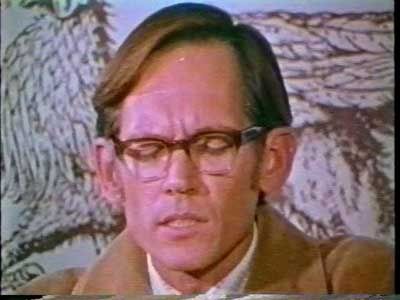
And so, finally, we get to the moment of the film where you will either fall in love with it, or begin to hate it with a burning passion, or both. For you see, the entire half hour of stuff covered above was merely filler material added to pad out another, hour-long picture made fifteen to twenty years earlier. This, perhaps, constitutes the titular ‘Curse of Bigfoot,’ since frankly there really isn’t another in evidence.
Yes, all these discursions, enough to make Herman Melville himself plead for mercy, were merely ingredients whipped together to manufacture something lengthy enough to play in a two-hour, late night TV slot. So let us say goodbye to Whitmore and Anne and Andy and Class Clown and Middle Aged Roger and say hello to Young Roger and a whole new bunch of friends!
Fittingly, this original films starts with…stock footage, library music and a blathering narrator. The transition really is seamless. Well, OK, that’s not true. Even so, the director’s technique clearly hasn’t changed much over the years, so there is a real sense of continuity between the new and old material despite the intervening decades. This proves especially true once we meet the younger version of Roger Mason, who was played by the same ‘actor,’ Bob Clymire, fifteen to twenty years earlier.
“In museums and universities throughout the world,” we learn, as we see a shot of the world-famous Lincoln County Museum, “archeologists are learning more each day about prehistoric man.” We then cut to a *cough* archeological dig, where a lone guy in a field jacket uses a simple garden spade to dig a body-sized trench. “Archeologists are highly skilled specialized scientists,” the Narrator explains. Well, clearly!
The Narrator continues to extol their virtues, such as the fact that they “know where to look, [and] what to look for.” (Wow!) Meanwhile, the fellow above uses a brush to uncover a plaster mask in the sand, which apparently constitutes “a discovery of tremendous importance.”
“This is the story of such a discovery,” the Narrator continues, and folks, THAT’S HOW A SEGUE’S DONE! We cut to footage of a high school, then venture inside to a classroom where two men and the aforementioned five students are gathered. Since this was the 1950’s, the ‘students’ (who typical of their cinematic kin all appear to be in their mid-‘20s) and the teachers sport rather more conservative hairstyles and clothing than their analogues in the more modern footage. Ironically, although they represent a time twenty years further back, they thus seem less dated to the modern eye.
For absolutely no reason whatsoever, this intro itself proves a flashback, with the Narrator establishing the events we’ll witness as occurring “a year ago.” Joining the students and the younger Roger Mason, their teacher, is Dr. Bill Wyman, “curator of the Lincoln County Museum.” Apparently that earlier shot of the museum wasn’t stock footage after all.
This initial scene is clearly shot in another real high school classroom, by the way. As often occurred back in the day (and probably still today), the fact that locals were shooting a *cough* real life movie clearly worked its magic on the filmmakers’ starstruck neighbors and town officials.
The ‘students’ were probably picked up from drama clubs or the local community theater. However, both Clymire and Bill Simonson, who played Wyman, assay their roles in a naturalistic fashion, completely bereft of the hamminess often evinced by small town thespians. Their understated line readings are certainly wooden and stilted—unsurprisingly, neither man ever appeared in anything else*—but still play better than if they had chewed the scenery. Contrast this with the ‘70s version of Clymire, who is required to Act!, and fares rather the worse for it.
(Indeed, this is again unsurprisingly true of the entire cast of the original film. However, some folks from the latter day footage, especially Augie Tribach, who played Whitmore, appeared in a few more cheapie movies and also some episodic TV work. His few other films were generally by the director of this one, Don Flocker—who is credited here as Don Fields—or Flocker’s brother J.T., who wrote this one.
Aside from Tribach, a couple of the ‘70s students appeared in a few other things. One again did some other stuff for the Flockers. The other, however, Jackey Neyman, appeared in Manos, Hands of Fate! Since that film was made in 1966, she of course played Debbie, the little girl. Those are the only two credits she has on the IMDB, but I don’t care what anybody says, that’s a hell of a career!)
The group is to visit an excavation site situated outside the small rural town of Ivanpah (Pop. 523), where they will look for American Indian artifacts. “Not one of these seven ever suspected that they would soon make a startling, terrifying discovery!” Yep, to their horror they will soon learn that the cottage they’ll be staying in gets absolutely no TV reception at all. Or maybe the Narrator was talking about the Bigfoot thing. (OK, it wasn’t supposed to be Bigfoot back when this was shot, just a prehistoric furry throwback, but we might as well go with the ‘Curse of Bigfoot’ thing.)
So they make their way in an old red pickup truck, with the ‘students’ sitting mostly up upon the side panels of the rear cargo area. Imagine a high school trying that today! Lawsuit City! Anyway, they soon travel through the metropolis of Ivanpah, and then into the country, through some commercial orange groves. (The evidence seems to point to the film taking place in California, although that’s a guess.) The music plays up how gently sylvan and bucolic all this is.
Eventually they reach the little house they’ll all be staying in. They enter the house, which for our purposes consists of the front room, where the student will bunk out in sleeping bags. Yes, all of them, boys and the girls alike. Obviously then the latter are little whores, especially since as girls they can’t really care about ‘science’ and stuff.
They also gab a little as they look over a rather dubious display of ‘artifacts.’ Some of the dialogue is nearly impossible to make out, because it was clearly recorded on scene and not re-looped later. The clarity of the dialogue depends on the timber of the voices, mostly. The girls are hard to hear because of the pitch of their voices, and the boys often mumble. However, the guys playing Roger and Bill have deep voices and e-nunce-i-ate clearly in a manner that generally registers jut fine.
They soon head out into the rock country where the dig is. “I bet you find quite a few Indian petroglyths up in this area,” Roger says, because he’s a science teacher and that’s how they talk. Linda, the whiny brunette girl (Sharon is the taller, more amenable blonde) of course doesn’t know what a ‘petroglyph,’ so Roger explains for her—and our—benefit.
Funny, isn’t it, how Linda doesn’t know any of this? I mean, Older Roger spoke of this group of students as being “especially fascinated with the study of archeology.” Frankly, there will be little such passion on display as things proceed. At best they seem to find it kind of neat, maybe, but mostly just seem to be here because that’s what the script says.
The group then walks to the actual dig site, which takes a while. Along the way, Bill shows them some highly doubtful ‘ancient’ (not to mention childlike) drawings on some of the huge rocks in the area. “These technically aren’t petroglyphs,” he explains, because they aren’t carved into the rock, but instead painted on with “berry juice stains.” Boy, you’d think stuff like that would have eroded off by now, what with being exposed to the blazing sun and the wind all these years. Bill proceeds to ‘read’ these doodlings in a not entirely credible fashion. “Basically, this is all just a big, primitive history book,” he maintains.
There’s a lot of time-wasting milling around—they have sixty minutes to eat up, after all—but eventually they move on. At the realistically tiny excavation camp, Bill shows them some pottery shards and ‘prayer sticks’ (utterly ordinary sticks). “That’s what we think they are,” Bill rather lamely asserts. “These prayer sticks may be over a thousand years old.” Sure, why not! Meanwhile, my friend Andrew and I during our dozens of viewing of this movie always laughed at how they then casually toss these sticks, supposedly ancient artifacts, down to the ground after glancing at them.
The boys get busy digging, while the girls shift, because, you know, they’re girls. One of the boys, Bob, finds a small shard of pottery. (‘Shards’ are likely all they will ever find, jabbing into the ground with spades the way they are.) Bill is impressed. “I want to take this back to the museum with us,” he says. Science!
With the dynamic, one minute-long excavation scene over with, it’s time for lunch. Oldsters like me will sign with nostalgia as they break out the old, clumsy metal coolers containing the paper bagged sandwiches and soda. I’m going to bet that at least one of them is eating liverwurst.
Bill is asked if they found anything “of value” this morning. “Oh, yes,” he replies, producing an apparently random rock. “For instance, this rock. This was used to grind up seed to make flour for bread.” Sure, why not! And you can’t ignore the proof! “Notice the worn edges on it?” There you go! They also found more pottery fragments and prayer sticks, both of which again get tossed around pretty casually.
One of the boys, Norman, takes in the lesson that finding rocks is “of value,” and thus produces one he himself found. Although this looks to be, you know, a rock, Roger is intrigued (“I haven’t seen anything like this”). He passes it on to Bill, who reacts with alacrity. “What’s wrong with it?” Linda mewls. She just has one of those grating, inherently whiny voices.
“This might be an eolith*!” Bill declares, “a very, very old tool, used by ancient peoples. This is by far the oldest thing we’ve found here.” Well, older than the sticks, maybe, but it’s possible some of the other rocks are as old as this one. In any case, Norman found this amazing specimen over by the Indian drawings, and Bill marches the group over there posthaste. Fortuitously, this is all of about ten feet from where they where sitting.
[*Yeah, it could be. However, as Wikipedia notes, “Because eoliths [[chipped flint nodules]] were so crude, concern began to be raised that they were indistinguishable from the natural processes or erosion.”]Looking around, they determine it might have rolled down from the top of the giant stone hill they’re standing next to. Sure, why not! They decide to go up and have a look. Modern viewers will probably laugh (I know I do) when the males all start their way up, while Linda and Sharon just instantly go “I think I’ll stay down here” and “Me to!” and then go sit on a rock. Because, you know, they’re girls.
Per venerable shoestring movie tradition, the ‘climbing’ and ‘looking around’ goes on for several minutes. Meanwhile, frenetic music strives to convince us that interesting stuff is happening. Then they finally reach the peak of the rock—which again, is really huge, like a stone hill—where suddenly Bob has a neatly tied length of rope. This is now official a motif. Do people just teleport objects to themselves in this universe?
They waste some more time—ours, mostly—and then eventually find a stone tablet set in the ground amidst some brush. This has scratches on it, which are inevitably declared to be primitive markings, “older than anything I’ve ever seen…these are the types of markings made by cavemen!” (!!!) Sure, why not? I mean, really, is all archeology a complete hoax? Or just the stuff they do at the Lincoln County Museum?
They decide—naturally—to remove this ancient, historical paradigm-shifting tablet, and hope to get it loose and back down the hill without breaking it. So they pull on it, and dig at it, and so on. “Whoever put that in there wanted it to stay!” someone exclaims. Eventually, though, they pull it free.
To their shock, this unleashes a cloud of thick white smoke. The tablet wasn’t just set in the ground like a marker; it was covering the entrance to a cave. Boy, lucky that rope magically appeared, huh? Anyway, everyone wants to go down, but eventually Bill, Bob and Johnny are chosen. (Bill, Bob and Johnny…man, they really spent a lot of time coming up with these character names.)
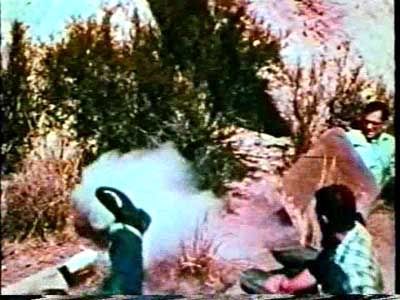
The passage down is narrow, and Bill leads the way. Once they’re all down there, one of the boys (it’s realistically dark here) finds some perfectly intact clay pots. These are full of wood ashes,* presumably the source of the cloud that exited the cave when the tablet was dislodged. Moreover, one has writing on it. “Those markings are similar to the ones on the tablet up above,” Bill notes. So apparently the two aren’t entirely unconnected, then!
[*Amazingly, Bill is able to tell the difference between wood and human ashes in nearly complete darkness. But then, he is a scientist.]Meanwhile, one of them stumbles across a (weirdly well-lit) side chamber. This contains a cairn upon which sits a perfectly preserved—one might almost described it as new looking—clay-covered humanoid figure. The others arrive and Bill labels the figure a “mummy,” although how he knows it’s not just a statue is beyond me.

Now, think about how important this find is. A cave full of perfectly preserved (at least until they let fresh air and sunlight in) artifacts from the Neolithic age, including a completely cherry mud-covered caveman mummy! I mean, really, that’s up there with the finding of King Tut’s tomb, right? Or arguably bigger, even.
So what’s their first thought? “How can we get [the mummy] out of here?” Bill’s answer, of course, is “We don’t, numbnuts, we close off that hatchway ASAP and get a team of top, world-class archeologists in here to document this astounding find before we even think of moving anything We’re going to need some more ropes from the truck, and some boards to tie it and hold it flat.”
That’s right, his plan is to, with the help of a high school science teacher and three students, break this thing loose, tie it to some boards with ropes, haul it up the tall, narrow chimney leading to the surface and expose it to air and blazing sunlight. Then, I guess, carry the damn thing to their pickup truck, stick it in the cargo area and drive along some fields and rough rural roads for a good long while.
To what end? Well, as it turns out, they plan to take it to the little house they’re staying in and, and I swear this is what they’re going to do, store arguably the single most amazing archaeological find in history inside a large garden shed.
Now, when you think about it, there’s no way they’re going to film any of the first part of that plan. Who would, with the level of resources these guys had? And sure enough, we just cut to them arriving in their truck outside the house. Still, you have to admire their chutzpas when they have somebody say, “Boy, I’m glad that’s over with!” Really, if you’re going to do that, you might as well have somebody reply, “I’ll say! And what about all those elaborate deathtraps we activated! And that tiger! I’m amazed we all got out of there alive!”
Moving the coolers aside (what, you’re going to leave some perfectly good coolers behind?), they grab the mummy and carry it to the aforementioned garden shed. To be fair, though, Roger does caution them to “Be careful bringing it in!” So it’s not like they’re being completely irresponsible.
Soon it’s safely tucked away inside the shed, following the whole thing where they broke it loose, carted it up a narrow passage, carried it outside in the air and sunlight, stuck it in the back of a pickup with some coolers and five *cough* teenagers sitting over it. “Are you going to dig it open and look inside?” one of the boys asks.
Of course not! Bill is, after all, a professional. “I’m afraid if we try opening it here we may destroy something,” he replies. By gad, sir, you’re right! Roger agrees, too. “Sometimes just exposing a body to the air will cause it to fall apart,” he explains. You don’t say!!
Meanwhile, they muse on the showroom new condition of the mummy. Bill has a theory. “I believe that some ancient tribe buried this mummy,” he conjectures, “not just thousands of years ago, but hundred of thousands!” Sure, why not! What’s his evidence for this astounding theory? LOOK, A FLUFFY DOG!
Bill further believes “they combined certain amounts of various woods and resins that were present on the Earth at that time.” Certain amounts, eh? And woods and resins present on the Earth at that time? Yes, that would certainly make things easier! “They put them in those earthen vessels we found and burned them in a sealed cave. The smoke and the incense have the power of preserving whatever was in the cave.”
OK, let’s connect the dots here. Let’s go all the way back to the earliest part of the film, the prologue (also the opening of the original Teenagers Battle the Thing version). There it was established that early man “would find his life threatened, terrified, by the appearance of a monster from the past.” Presumably, then, the mummified being was one such “monster from the past.” So after they captured it and covered it in a protective shell and stuck it safely away down inside an underground cave, why would they go to all that effort to preserve it?!
Then Norman (I think, the ‘boys’ are rather generic with their gangly forms and matching haircuts) asserts that he saw the mummy move. (Bum bum bum!) He is ridiculed, naturally, but maintains his claim. Anyway, they all decide to go inside and eat dinner.
Later they are sitting around the living room, rather tightly packed and with an entirely naturalistic klieg lamp glaring at them to light the scene. (It’s clearly a real room in a real house, explaining why the window is covered over with something like heavy blue construction paper.) We find—I hope you’re sitting down—Linda whining about staying below when they found the mummy.
“Next week all the newspapers will make a big story about how we found a mummy,” she complains. “Maybe even a magazine!” But she won’t be able to share in this media firestorm, she moans. “I was too afraid to climb up on the rock!” This ‘comic relief’ conversation is actually dragged out for a while, because, again, sixty minutes of running time. I mean, they still have twenty-five minutes left even after this scene, with nothing to focus on other than a rampaging, prehistoric Bigfoot monster.
With Linda’s concerns finally by the boards, Johnny decides he’d like a “bottle of pop,” (yes, soda used to come in bottles, children). Yep, they’ve really got their eyes on the Bigfoot prize, eh? Anyway, Bill mentions the town store is open. Johnny can walk there by cutting through the orange groves. Sharon says she’ll go along. You know, I don’t care; two adults overseeing a field trip allow a teenage boy and girl in their care to head off on their own into the night? I don’t think so.
Further comedy ensues when Bob (I think) requests they bring him back a bottle of orange pop. In what I guess is meant, somehow, to be remotely funny, Johnny (I think; seriously, I should have it down by now but I just can’t keep these guys straight) demands the dime this will cost. After getting it, he then assumes an ever slier look and requests another three cents for the bottle deposit. Bazinga!
So Johnny and Sharon head out into the trees, holding hands. (I told you that girl was a whore!) Meanwhile, Norman, still fretting over what he saw earlier, goes to the shed to check out the mummy. Sure enough, it begins moving around and he beats feet back to the house. He incoherently informs the others, and they run outside to have a look. They supposedly see something run into the grove, but the film is so dark we ourselves can’t see a thing. Needless to say, the shed itself proves empty except for the blanket and pieces of the shattered clay shell.
Following this we actually do get a hard-to-see shot (our first since the prologue) of the really incredibly scraggly monster shuffling through the grove. And with just over twenty minutes of movie left, that leaves lots and lots of time for awesome, non-stop Bigfoot action!
With harp music (!) on the soundtrack, we cut over to see Johnny and Sharon. They are still walking hand in hand and leaving the store with the aforementioned soda pop. They talk about the stars and how nice it would be to live in the country, and, well, you know…young love. Isn’t it nauseating? Anyway, they head back…through the orange grove! (Bum bum bum!) These shots were patently filmed in broad daylight—and they don’t even dub in crickets!—but because of the shadows cast by the trees we still can’t really see anything.
Meanwhile, the others have ridden into town, presumably hoping to find Will and Sharon before they head back. Roger runs inside the store, only to learn he’s too late. Meanwhile, in the “can’t see a damn thing” groves, the kids hear something scary and run, only to smack right into…one of the other guys. I really can’t see anything here, so don’t ask me who.
Finally, with an entire seventeen minutes of movie left, we get our first actual Bigfoot attack since the one in the prologue. Not that this is anything to write home about. A woman is sitting in her living room. We see Bigfoot lurking outside. They show a window shattering (clearly candy glass), and…how do I describe this?
Apparently it was too awkward to have the guy in the suit climb in through the window. So they just repeat a brief bit of a zooming close-up of Bigfoot’s face from earlier in the movie—which again focuses our attention on the eyehole cut into the mask—to imply that he’s approaching her. (Despite the fact that this shot was in, again, broad daylight, and that there is highly inappropriate greenery behind the beast.) Take that, Harryhausen! Anyway, this dynamic sequence eats up another couple of minutes. And needless to say, the woman’s demise occurs off-camera.
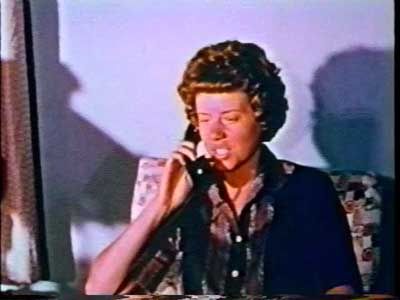
The next day the Walt the Sheriff arrives at the group’s house in a really awesome old, black, hearse-like station wagon. This vehicle is easily the coolest element in the movie. After a confab, Walt admits that he is only buying their story because he knows Bill, and because of the woman’s death. They decide to examine the shed, and we watch as they walk all the way over there. Because, again, that’s just not the sort of stuff you ignore. Bill describes the barely glimpses creature as “larger than a man.” I’m assuming the man they mean is Dudley Moore.
“The orange and lemon groves in this part of the country are so extensive,” Bill explains, because as an archeologist he’d surely know more about this particular subject than the local Sheriff, “the thing could travel for miles and never leave the protection of the trees.” They then go check out the groves. At they pace they’re walking, they should have the area covered in several years. Still, if watching a group of men saunter through some trees at great length is your cup of tea, well, have I got the movie for you! And the bit where we watch all four of them in sequence jump over a small creek is just dynamite.
And then more walking! Whew! I’m burning up with excitement. Eventually, they find some broken branches and some blood. There was a report of a guy shooting at the Bigfoot, and Bill theorizes that this must be his blood. “What makes you say that?” he’s asked. Yes, this thought processes on this are quite a mystery. “This isn’t ordinary blood,” he replies, gazing at it whilst sitting in the deep shadows from the trees. “This is too dark in color.” Boy, is he going to be embarrassed when he sees the sample in proper lighting.
The Sheriff maintains, though, that the guy couldn’t have hit the creature. “I saw the gun that he used,” he answers. “A large caliber. Three shots from that would have stopped anything.” Well, that begs a lot of questions, but I think the takeaway is that the Bigfoot is more or less bulletproof. As, indeed, you’d expect it to be.
Then we cut to a close-up of Roger, and Wham!, the shot is suddenly super-bright. Roger opines that the Sheriff’s less-powerful revolver would presumably be ineffective against the beast, too. And since tracking it in the trees is so dangerous, he suggests laying a trap for the monster and drawing it into an open field.
Cut to the laying of said trap, which makes those elaborate Rube Goldberg-like snares the Mystery Gang used to set up seem like a model of efficiency. First, there’s the fact that the adults are allowing the students to take part in all this. Yes, if I were responsible for a group of kids, I’d certainly want them standing around the area where I was planning to lure a bulletproof monster.
But more to the point, about the only thing they’re doing is building a wall of hay bales. Indeed, that’s too generous. They merely haphazardly stack about a dozen bales of hay, and then they stand behind the result. Apparently this fortress represents their idea of a ‘protective barrier.’ Indeed, they seem proud of their work. “That should just about do it, shouldn’t it?” Norman asks, and Roger agrees.

Wow, and I thought the Maginot Line was poorly designed. Seriously, with decades and hundreds of dumb movies since I first saw this picture, this remains one of the stupidest things I’ve ever seen. Otherwise their plan involves setting out buckets of petrol. Apparently having seen The Thing from Another World, they plan to toss the fuel onto the Bigfoot and then set it alight. This scheme, astoundingly, makes hiding behind a wall of dried out hay bales even more ingenious.
The bait is to be several large packages of meat scraps the Sheriff brought in from town. Yes, that should be enough to bring out a monster hiding somewhere within hundreds of square miles of tree groves. Then they will station someone overlooking the trail of scraps to radio in and warn them of the creature’s approach.
This established, the three adults start gallantly arguing about who will be the one taking the dangerous job of baiting the woods. Following this display of manly fortitude and self-sacrifice, they eventually decide to choose straws. Roger draws the short one, and heads off into the woods with the meat and the Sheriff’s revolver.
After all that falderal with the straws, Roger quickly returns safely to the Impregnable Wall of Hay and waits with the others for the Sheriff’s alert. (Speaking of the Maginot Line, they all stand around staring in the same direction. What if Bigfoot, like the Germans before him, came through Belgium behind them?)
Indeed, after a while—and, as you’ve probably learned by now, I mean a while—and with full Ironicfullness, it isn’t scrap-layer Roger in the woods who is ambushed by the creature, but the Sheriff doing radio duty. Proving quite the brainiac, he decides to investigate—yes, for a while—a noise in the surrounding foliage, and apparently gave Roger his revolver despite not carrying a shotgun or rifle in his patrol car. (What kind of rural cop is that?)
Meanwhile, in the brush we see Bigfoot, via the same damn close-up used in the beginning of the film, and during the attack on the woman. Really, they couldn’t shot more than 40 seconds of Bigfoot footage, but had to repeat this same shot three times? Then he finally rushes the Sheriff, in again the same rushing footage we saw earlier with the caveman attack. (By the way, the Bigfoot clearly stands about three inches taller than the Sheriff, which rather fails to make him a ‘giant,’ as we’ve been constantly told.)
Anyway, now that we’ve finally gotten to the monster stuff, now the filmmakers rush things. Failing to raise Walt on the radio, the rest of them all decide to troop over to his location, buckets of gas, flares and all. (FOOLS! YOU’VE ABANDONED THE ABSOLUTE PROTECTION OF THE WALL OF HAY!) I will say this, at least they’re *gasp* smart enough to all stay together in a single group.
Oops, spoke too soon. Maybe ten yards from the car, Roger halts the others and continues on alone. (??) Sure enough, Bigfoot jumps him and he fires his revolver at it, to little effect. Or, for that matter, excitement. (Fourth use, at least, of the Bigfoot close-up.) Suddenly, though, all the others are standing right there, and they toss the petrol on the creature, and light him up, and he goes up like a dummy filled with straw whose waving arms are being manipulated with strings.
[By the way, several of the actors misjudge where the huge, and quite real, pool of petrol extended, and are quite nearly burned themselves. It’s just like the scene in The Giant Claw where Jeff Morrow is missed by hand tossed flaming debris by about two inches.]So we watch the fire for a few seconds, and then spot the Sheriff, holding his arm but otherwise all right (LAME!), and then the movie ends. I have to say, we got one last quick glance at the kids, and frankly none of them seemed that traumatized. So much for that “three of them are in a mental institution for life” business. On the other hand, we can only hope it was whiny Linda who was the girl who never spoke again. At that point you’d have to call the whole “rampaging monster” thing a draw.
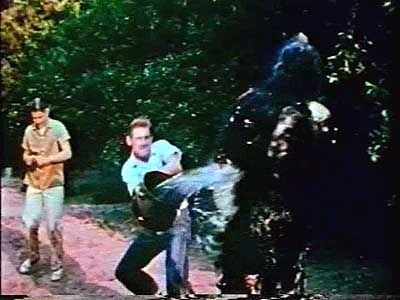

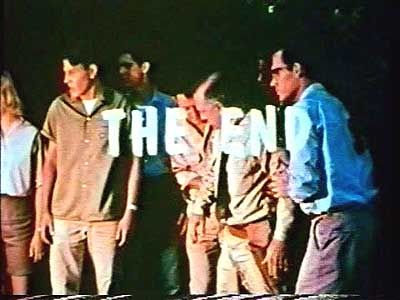
This DVD-R is about the best presentation you’re likely to get, although as you can see, that’s not saying much. Still, it’s better than the Alpha copy.
However, you can also see the movie for free on the Internet, here. You can also see the original, unaltered Teenagers Battle the Thing.
AFTERWORD
Curse of Bigfoot is perhaps most interesting as an example of good, old-fashioned cinema huckstering. The original film, the 60 minute Teenagers Battle the Thing, was an attempt at a typical regionally made drive-in teens vs. monster flick. From there, though, the timeline gets rather murky.
Accounts vary, but the original film was apparently produced circa 1958. If so, it’s a bit surprising that it was shot in color. Admittedly, the film in whatever limited release it had—including an eventual VHS release under the Teenagers title—was printed and distributed in black and white. Still, the fact that the negative was in color is what allowed it to be expanded and resurrected nearly two decades later.
Many sources list the revamp as occurring in 1972, fourteen years after the initial shoot. This seems credible given the awful clothing on display in the school room scene, and the reappearing actor playing Roger does seem roughly that much older. However, Whitmore clearly refers to both The Exorcist and Jaws (albeit in a bizarrely elliptical fashion), which were respectively released in 1973 and 1975. In any case, if the IMDB is to be believed, the revamped Curse of Bigfoot eventually sold as a TV property in 1978.
This would make sense given then current pop culture trends, which Teenagers director “Don Fields,” a.k.a. Dave Flocker, apparently decided to take advantage of. Perhaps because of the general hippy weirdness and Gaia-worship and so on of the ‘60s, the ‘70s saw a big surge of interest in various New Age-y foolishness. This included a sudden ramping up of interest in supposedly ‘real-life’ monsters like Bigfoot and the Loch Ness Monster.
The biggest manifestation of this was a series of half-assed ‘documentaries’ in the mode of 1970’s Chariots of the Gods. This German flick, adapted from an insipid but best-selling tome by Erich von Daniken, established an entire sub-genre of pseudo-documentary that tended to ask lots and lots of questions while answering pretty much none of them.
As noted, one of the biggest manifestations of this sort of thing centered on what we would today call cryptozoology. The most successful result was another pseudo-documentary called Mysterious Monsters (1976). Narrated by an apparently hard to embarrass Peter Graves in his best ‘no irony whatsoever’ mode, this played in actual movie theaters and drive-in across the country before taking a quick trip to TV screens. There it joined lots of similarly-themed television specials, as well as the ongoing syndicated series In Search Of…, as narrated by Leonard Nimoy.
Indeed, Mysterious Monsters was but the most successful such film from the company that became most associated with the pseudo-documentary, Sunn Classic Pictures. Sunn began life by producing and distributing ‘wildlife’ films like The Adventures of Frontier Fremont and The Life and Times of Grizzly Adams. They also produced a hilariously pompous TV version of The Time Machine.
However, they quickly gleaned that there was a market for purportedly ‘factual’ fare like Mysterious Monsters and In Search of Historic Jesus. They also merged the two genres with forthrightly fictional but ‘speculative’ flicks like The Lincoln Conspiracy and the alien encounter conspiracy picture Hanger 18.
Sunn nearly hit the big time when they helped produce the Stephen King movie Cujo, but otherwise mostly produced more made-for-TV movies before taking down their shingle in the late ‘80s. They also inspired a fair share of competitors, including the late from the gate apocalypse entry The Jupiter Menace. Released in 1984 (!), this was hosted by a chagrined-looking George Kennedy, who could barely squeeze into his safari jacket.
In the end, the most successful strain of pseudo-documentaries was the Bigfoot ones, which ranged from Mysterious Monsters to 1972’s markedly successful The Legend of Boggy Creek. Produced by veteran schlockmaven Charles B. Pierce, Boggy Creek was successful enough to kick of a whole batch of sequels and imitators. Some of these played the pseudo-documentary card, some didn’t, but it’s like that many of the films reviewed for this roundtable resulted from Boggy Creek’s success.
Sometime during all this, Dave Flocker apparently realized that he had a barely seen monster movie sitting around, one that featured a furry (if moth-eaten) beastie in the woods and which, again, had fortuitously been shot in color. Dusting this off and padding it out an extra 30 minutes of stock and newly shot footage, Flocker turned Teenagers Battle the Thing into The Curse of Bigfoot. The film went on to become a legendary late night mainstay on cheapie UHF TV stations across the country.
Of course, the monster was never supposed to be Bigfoot, and is never referred to that way in the original feature. He certainly isn’t ‘giant,’ as Bigfoot is incessantly claimed to be in the newly added material. Even so, the Frankensteined version, as amusingly insulting as it is in a way, garners real juice from Flocker’s ability to bring back actor Bob Clymire as Roger Mason.
Isn’t this one reason we watch these obscurities? Here Curse of Bigfoot is this dreadful little picture, and yet in one aspect, it’s possibly unique. How many times has an actor appeared, at length, in a single film in scenes shot nearly twenty years apart? It really lays bare how inadequate old age make-up is. Luckily, we usually suspend disbelief in this matter like we do in so many other ways. Even so, Clymire’s return really ties the new and old material together in a way that otherwise would be impossible.
Curse of Bigfoot: The Musical (A work in progress)
Bigfoot Encounter
(Sung to “The Ballad of Jed Clampett”)
Once there were some hunters
looking for some deer
So they drove around the forest
never leaving first gear
They drove around real long
And they drove around real slow
‘Til a man in a fur coat
run across the road
SPOKEN:
Coulda been a man; coulda been a Bigfoot
Well the first thing you know
they jumped out of their Ford
and the driver in his stocking cap
set out to explore
He picked up a stick
to see to his defense
Then he put it back down
and he picked it up again.
He walked up a hill
and he came back down
And he walked around a long time
There was nothing to be found
His friend was getting bored
standing back by the truck
When he heard an awful scream
and knew that they were screwed.
SPOKEN:
Found his friend gibbering. Didn’t look hurt, though. Scared by Bigfoot, I reckon.
The Dog, the Lady and the Monster
(Sung to “The Battle of New Orleans”)
Once there was this hound dog
sitting in this yard
Just lolling out his tongue
and kinda keeping guard
The crickets all were chirpin’
Twas the middle of the night
Which was kind of peculiar
‘Cause the sun was burning bright
Chorus:
Out in the woods
a monster was a’creepin’
Least I guess he was a monster
‘cause his skin was really bad
He was movin’ so slow
the audience was sleeping
or staring at the TV set
and getting’ kind of mad
Well that dog he started barkin’
and he started raising Cain
and he woke up his mistress
and she came out to complain
She poured that dog some milk
and then she did query
“Must you bark at every
jack rabbit that you see?
Chorus:
Well, out in the woods
that monster still was coming
Though I couldn’t figure out
how come he moved so slow
The scene was so dull
my head it started nodding
I barely could keep conscious
‘cause my interest was so low
Well finally that monster
came to that backyard
And he snuck up on that lady
and he caught her off guard.
And while this all was happenin’
that dog made not a sound.
So if you’re looking for a watchdog
Well I wouldn’t buy that hound.
The Curse of Bigfoot
(Sung to “Our House” by Madness)
From the hilltop they did wave
then turned around and found a slab
covering a cave
From the cave issued a cloud
(LA LA LA)
Guess it was sealed back in the days
when smoking was allowed
There they found
BIG-FOOT
He was covered up in clay
BIG-FOOT
So they chipped it all away
BIG-FOOT
And they stuck him in a shed
BIG-FOOT
And he came back from the dead.
Yes Bigfoot came back to life
To terrorize the neighborhood
and kill somebody’s wife
Bullets they did not take a toll
(LA LA LA)
In this film he’s the only thing
that isn’t full of holes
Look out there’s
BIG-FOOT
Now he’s hiding in some trees
BIG-FOOT
Looks to me like he’s got fleas
BIG-FOOT
He smells bad when he gets wet
BIG-FOOT
Has relatives in Tibet
Now three men are tempting fate
picking straws to see which one
will end up Bigfoot bait
Then they build a wall of hay
(LA LA LA)
Please explain how this would
help to keep Bigfoot way
And then came
BIG-FOOT
Now he’s finally made the scene
BIG-FOOT
Now he’s doused with kerosene
BIG-FOOT
So quickly goes up in flames
BIG-FOOT
That he puts Kingsford to shame
BIG-FOOT
And that’s how our story ends
BIG-FOOT
Say, which one never spoke again?
*******
Click on the banner to go the roundtable supersoaker!
